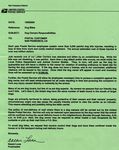 |
| Angelika/Mike Schilli |
|
Angelika We have been complaining a lot in the newsletters lately about American health insurance, but never mentioned that there is also a government provided health insurance, which may sound surprising in hard-core capitalist America. It's only for retirees, and it's called "Medicare". A glorious exception! Every retiree can join this government provided health insurance, starting at 65 years of age (for now). People under 65 with certain disabilities or diseases like severe permanent kidney failure are eligible for Medicare benefits. The whole thing is financed by the state withholding 1.45% (as of 2005) of the employee's gross salary. The employer also contributes 1.45% - a similar principle as you know from Germany. Self-employed workers pay 2.9% (employer plus employee contribution) into the pot. As a rule, one has to have paid contributions oneself or through one's spouse for at least 10 years in order to receive benefits later. The system of "Medicare" was founded in 1965.
Traditional Medicare insurance distinguishes two areas: hospital insurance (Part A) and insurance for doctor's visits and other outpatient services (Part B). For hospital insurance, the retiree pays no monthly contributions, but a one-time self-participation of $912 (as of 2005) for hospital stays from 1 to 60 days. Stays from 61 to 90 days cost the retiree $228 per day. This amount increases to $456 (!) (you read that right) per day if the insured patient has to stay in the hospital between 91 and 150 days. After 150 days, there are no more Medicare benefits for hospital stays. However, if the patient has left the hospital for 60 days, the insurance will intervene again upon re-admission. The patient will, however, have to pay the aforementioned amounts again, i.e. the self-participation applies per stay and not per year.
The second part of Medicare, which covers doctor's visits, etc., currently costs a monthly premium of $78.20. The annual deductible for 2005 is $110, after which Medicare reimburses 80% of the accepted doctor fees -- the patient is responsible for the remaining 20%.
If you haven't fallen asleep while I was quoting my numbers, you've noticed that the co-payments are enormous. Even with Medicare insurance, retirees facing long-term illness are facing bankruptcy. Therefore, private insurers offer so-called "Medigap" insurance ("gap" = gap) to close the supply gap and minimize co-payments. Private Medicap policies are subject to state guidelines. Premiums vary from insurer to insurer. Of course, the amount also depends on how much protection the individual wants. Neither traditional Medicare insurance nor Medigap insurance, by the way, covers dental visits, eye examinations, glasses or hearing aids, or long-term stays in nursing homes.
Since America has been known to privatize everything and anything, the government early came up with the idea on allowing private providers alongside the traditional, state-run Medicare insurance, as long as they offer retirees insurance with at least the same benefits as the state Medicare. These private insurances are now grouped under the name "Medicare Advantage". Generally, their range of services is larger and the co-payments are smaller, but the insured is subject to restrictions, for example regarding the choice of doctor ("managed care") and often has to pay an additional fee for the additional services in addition to the monthly premium of $78.20 (see above).
Interestingly, traditional Medicare insurance won't pay for medication (I mean prescription ones -- for the others you have to pay yourself anyway), which is a catastrophe for many retirees, since the need for medication increases with age. Those who cannot afford private insurance are left out in the cold or are going on a weekend trip to Canada to get the medications more cheaply. We often read in the newspaper that older people do not take the necessary medications regularly because they lack the money to fill a prescription or only take half the prescribed amount.
This medication issue is a topic on every election campaign, because in America, retirees constitute an important voting bloc. By the end of 2003, after a long political struggle, it was finally decided: Medicare would include payment for medications - albeit with many restrictions - by law. 2004 and 2005 are considered transition years: the Medicare recipient receives a discount card which they present when purchasing medication, giving them a 10-15% savings. Starting in 2006, if the retiree has fulfilled their $250 deductible, Medicare will cover 75% of health care costs up to $2,250. If the individual's medication expenses then fall between $2,250 and $5,100, the insurance will not pay anything. Above $5,100, the retiree must contribute 5%. Additionally, there is a general monthly premium of approximately $35 for the prescription drug insurance. Now, $2,250 may sound like a lot, but I tell you, prescription drugs in America are incredibly expensive. The new regulations smell like a bad compromise to many, but President Bush and his Republican party were not willing to negotiate with the pharmaceutical industry to set prices for medications, as many Democrats wished.












